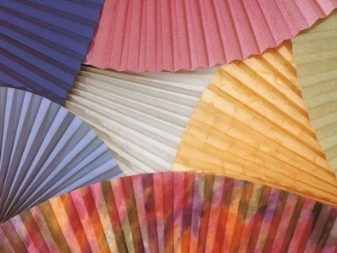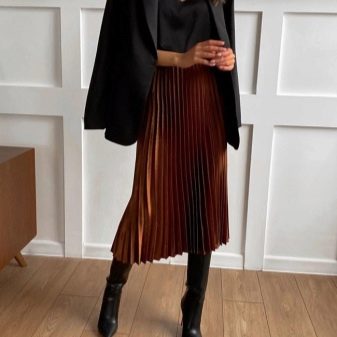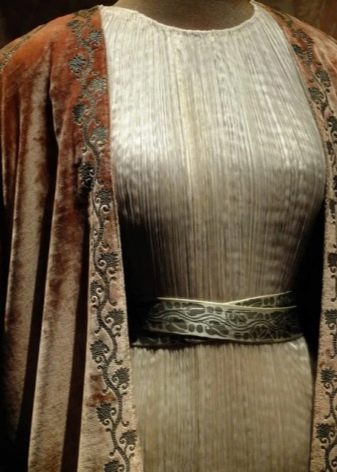What kind of pleated fabric is and what can be sewn from it?

Pleated fabric is in special consumer demand. Those who love handicraft should learn more about the characteristics of this fabric, its features, and methods of caring for it.



What it is?
Pleated is a textile with many parallel vertical folds of identical width, keeping their shape after washing. This is not a specific type of material, but a fabric that has been folded into shape. Its composition can be varied. The width of the folds varies between 0.5-5 cm. Compared to the corrugation, they are flat, parallel to each other and resemble an accordion assembly.
The name "pleat" comes from the English pleat ("fold"). Initially, this fabric was used to decorate linen and cotton men's clothing. Pleated fabric is made of wool and other materials. The technology for the production of even and stable folds was developed in the nineteenth century. Materials of different thicknesses and densities were used to create folds. The peak of mass production of folded fabrics occurred in the middle of the last century.
The texture of the material is usually smooth, without a relief pattern. It is available in matt and glossy sheen, metallic and glossy effects.


Advantages and disadvantages
Pleated textiles have a number of features. It adorns various details of women's clothing, looks spectacular and sophisticated. Such fabric will not go out of fashion, as it is considered a classic. Pleated clothes are suitable for women of different ages. It does not hinder movements, is comfortable to wear, adheres to the body. The best property of texture is the ability to stretch the silhouette. Thanks to this, figure flaws are corrected.


Pleated fabric can be perfectly combined with any clothing. A similar fabric is used as the main form and decoration of products. The material can be transparent or opaque. Pleated blinds rarely wrinkle, the fabric keeps its shape perfectly and does not need to be ironed after washing, spinning and drying. It flows perfectly, repeating the contours of the silhouette. In fine fabrics, it creates the effect of lightness and weightlessness. In products it is located not only vertically, but also horizontally.



Elements of women's wardrobe can be sewn from such material in a wide variety of styles. It adds romance and femininity to the image, does not limit the length of dresses, skirts and trousers. It can be classic, floor-length, midi, above the knee. In some cases, it is completely minimal, which does not in the least reduce the aesthetics of the products. Along with this, the gathering of the pleats increases the cost of making pleated pleats. The production technology is lengthy and laborious.

It is performed on specialized equipment (presses and finishing tools). Plisse is by no means a universal type of texture. In order for it to look appropriate in a particular product, it is necessary to thoroughly choose the style, silhouette, correlating with the thickness and composition of the fabric. The material used for interior decoration should have a maximum width. It cannot be used for panoramic glazing.
Due to the fact that pleated pleats are folded almost three times, it is more expensive than ordinary fabrics. A large print is rarely applied to it, since folds distort the pattern.


How is pleating done?
The method of industrial production of pleats was created and patented by Mariano Fortuny y Madrazo in 1909. It was based on the use of pressing equipment. During production, under the influence of high temperature and the weight of the machine, the material is pressed into folds. If synthetic fabric is processed, the fibers are sintered at the folds.


This ensures the desired result. To form pleats from natural fabrics, special impregnations are used. At home, it is made using a paper template, an iron, and an aqueous solution of vinegar. For greater durability of folds, use laundry soap or an adhesive composition. However, such manipulations are not a guarantee of the preservation of folds. Almost always, after washing, they have to be corrected, which is quite laborious and time-consuming.

What can be sewn?
Pleated textiles are used for the production of clothing and interior decoration. It makes unique products with a simple cut, it is used in the sewing of skirts, blouses, tunics. It adorns dresses and trousers, and, depending on the density, is used to make not only light, but also outerwear. It makes beautiful cocktail dresses and sundresses, as well as warm woolen coats.
Pleated elements of pleated fabric, such as chill molds, collars, cuffs, flounces, yokes, ruffles, look very elegant and delicate. Inserts on the bodice of dresses are made of such textiles for visual breast enlargement. The classic application is a school uniform for girls of different ages and basic elements of a business woman's wardrobe in a simple style. For such clothes, both plain and checkered textiles are used.


Pleated fabric is a textured fabric for curtains of any configuration, curtains, lampshades. It is used to decorate poufs, sofa armrests, bed headboards. It can be used for sewing fancy and themed tablecloths. Looks spectacular in the decoration of handbags and hats, as well as summer shoes. Even lambrequins of classic and arched windows can be pleated.
Plisse is used to decorate banquet halls, hotel rooms, halls, restaurants. It is used in the production of modern pleated curtains, folding according to the blinds principle. This fabric has a special treatment.Its folds are larger than 5 cm, which is required by the technology of opening and closing curtains, the size of which almost always corresponds to the size of the window opening.

Views
The varieties of pleated fabric can be classified according to different criteria. In composition, it can be natural, artificial, combined. Chiffon, velvet, silk, polyester can be used in production. Leather is also used in production. Each type of material has its own characteristics.
- Polyester keeps its shape perfectly. It is resistant to fading and creasing. It has a matte surface and an opaque structure with a complex weave of threads.

- Knitwear is cotton, viscose, woolen, synthetic. The weave of the material is looped, it stretches perfectly in length and width. Pleated knitted pleats are thicker than others.

- Velvet is one of the densest materials to be pleated. It has a short pile, which increases the thickness of the folds. Pleated velvet makes the figure look fat.

- The satin fabric is characterized by a twill weave and a characteristic shiny sheen. It crumbles along the edges, deforms diagonally, and is used for smart clothes.

- Pleated mesh is used to make specific clothing (tutu skirts, stage images). Artificial material, transparent, resistant to stretching and deformation.

- Chiffon is one of the most capricious translucent fabrics. This is reflected in pleating as well. Chiffon pleating is thin, but wrinkles after washing. It has a matte texture and vulnerability to holds.

- Crepe satin pleated fabric may have weasels, which are formed during the assembly of folds. The material itself crumbles heavily, it has a matte surface and a complex weave of threads.

The most popular mixed options are made from:
- silk with the addition of viscose and acetate fibers;
- semi-woolen fabric, cashmere and lycra;
- linen-elastane materials;
- a combination of cotton, viscose and polyester.
In terms of color, fabrics are divided into 2 groups: plain and printed. Variants of the first group have many shades, including neutral, pastel, bright, acidic, dark, muted colors. The colors depend on the density and purpose of the fabric.
Dress materials are decorated with floral, plant, geometric prints. Popular designs are peas and a cage. They are used for sewing business-style clothing.

Care
The care of pleated fabrics depends on the characteristics of the raw materials used. Some materials are handed over to dry cleaning, fixing along the edge, others are washed by hand. In the first case, the folds are fastened with a large stitch with white threads. This eliminates the likelihood that they shed. If you do not want to manually sweep the bottom, then this is done on a typewriter, choosing the maximum stitch length. However, the chemical method is far from always justified, as is the fixation of folds. For example, products made from synthetic suiting fabrics often do not need this.
Thick polyester fabrics keep creases well even after washing in a washing machine if washed on a delicate cycle in lukewarm water. Thin and mesh materials should not be exposed to this. Clothes are washed by hand in warm water, the temperature of which does not exceed 30 degrees. Do not soak the product for a long time and bleach if stains are noticed.

For washing, you need to use the appropriate type of powder, which is indicated on the package. Hand wash varieties are characterized by increased foaming. They require better rinsing. Mild liquid detergents can be used. To prevent the texture from losing its softness and flowing effect, add fabric softener to the tray.
It is better to wring out the thing with your hands, which is especially important for cotton, viscose, chiffon products. In some cases, it is best to let the water glass yourself. It is better to dry the product in an upright position.In order not to deform the parallelism of the folds of the skirts, they are hung on the hangers, fixing with the existing clamps. If the dried item needs ironing, use the steaming mode.
The product can be ironed exclusively through an iron made of fine natural fabric.

If there is a temporary firmware below, proceed as follows. First, the thing is laid out on the ironing board, then the folds are straightened so that they lie parallel and do not look in different directions. An iron is placed on top, an iron is placed on it to fix the form. So that after ironing there are no temporary stitches left, remove the iron, remove the thread, cover the product with a cloth again and steam the bottom.
Gauze folded in half is not always suitable for this. If you iron chiffon or other thin fabric through it, the smooth texture becomes porous, taking on the "pattern" of gauze. It is better to store pleated clothes on hangers. To keep them from gathering dust in the closet, they can be packed in cotton covers. Do not store clothes too tightly, tamping them between other things.









